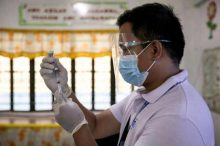 The Inter-Agency Task Force (IATF) approved testing and quarantine protocols on December 2, 2021, for arriving international passengers from countries/territories/jurisdictions that are not listed as Red List countries/territories/jurisdictions in all ports of entry in the Philippines. The new standards have been implemented on December 3, 2021.
The Inter-Agency Task Force (IATF) approved testing and quarantine protocols on December 2, 2021, for arriving international passengers from countries/territories/jurisdictions that are not listed as Red List countries/territories/jurisdictions in all ports of entry in the Philippines. The new standards have been implemented on December 3, 2021.
Individuals who have been fully vaccinated must have a negative RT-PCR test completed within 72 hours of departing from their country of origin. They will be subjected to facility-based quarantine upon arrival in the Philippines, with an RT-PCR test performed on the fifth day, with the date of arrival being the first day. Regardless of the result, they will be subjected to home quarantine until the 14th day after their arrival.
Individuals who are unvaccinated, partially vaccinated, or whose vaccination status cannot be independently validated will be required to do a negative RT-PCR test within 72 hours of departing from their country of origin. They will be subjected to facility-based quarantine upon arrival in the Philippines, with an RT-PCR test conducted on the seventh day, with the date of arrival being the first day. Regardless of the result, they will be subjected to home quarantine until the 14th day after their arrival.
The Department of Transportation has been directed to ensure that only passengers who pass a negative RT-PCR test before flying are allowed to board. Minors’ testing and quarantine protocols, on the other hand, must follow the parent/testing guardian’s and quarantine protocol, regardless of the minor’s vaccination status or country of origin. International travellers who have already arrived and are undergoing quarantine must follow the testing and quarantine protocols in effect at the time of their arrival.
Filipinos from countries/territories/jurisdictions on the Red List are only allowed to enter through government-initiated or non-government repatriations, and Bayanihan flights can only land at Ninoy Aquino International Airport and/or Clark International Airport. The Department of Transportation, through its associated agencies, is responsible for ensuring that airlines follow the directive. The individual must follow the testing and quarantine protocols outlined in IATF Resolution No. 149-A (s.2021) once they arrive.
At the same meeting, the IATF revised the parameters used to classify provinces, highly urbanised cities, and independent component cities into alert levels. The One-Week Growth Rate will no longer be used as a metric for escalation from Alert Level 1 to Alert Level 2; areas in Alert Level 1 will be escalated to Alert Level 2 if either case classification or total COVID-19 bed utilisation increases to moderate risk or higher; and areas in Alert Level 2 will be escalated to Alert Level 3 if both case classification and total COVID-19 bed utilisation are at moderate risk, or if case classification is high to critical.
Apayao will be classified as Alert Level 2 from December 3, 2021, to December 15, 2021, based on the revised metrics.
 Tourism Breaking News
Tourism Breaking News


